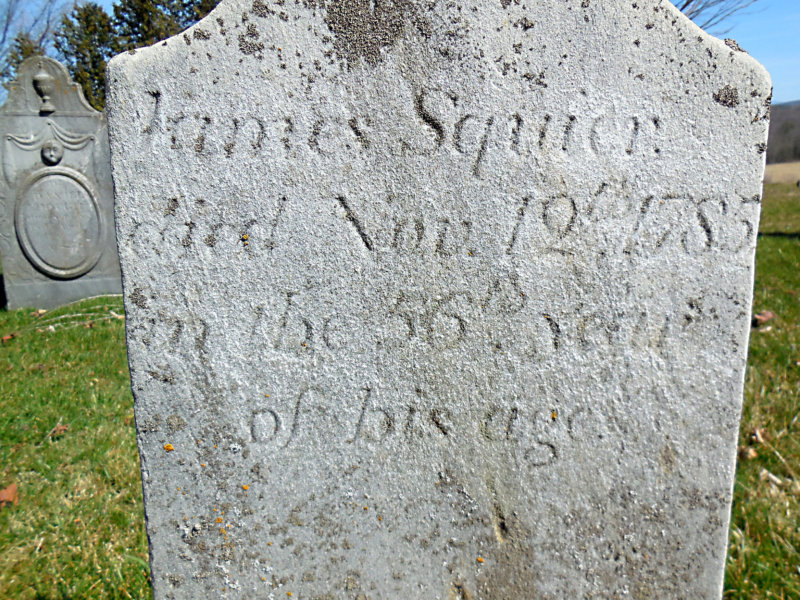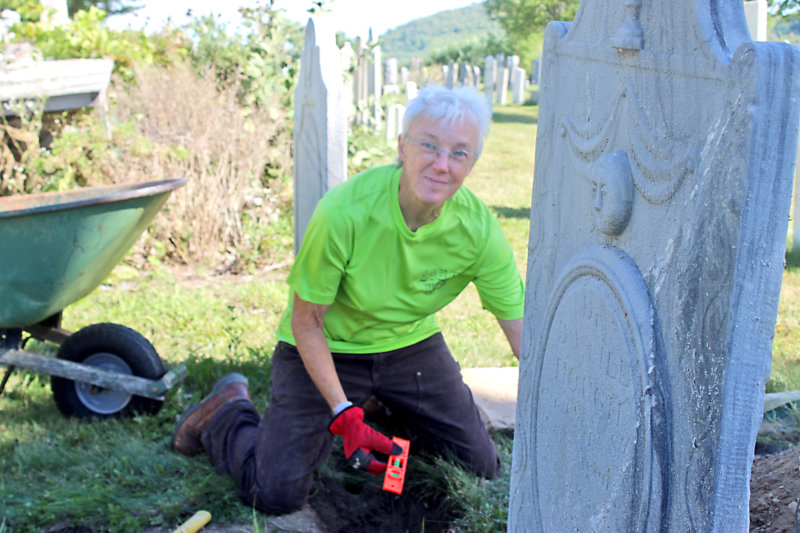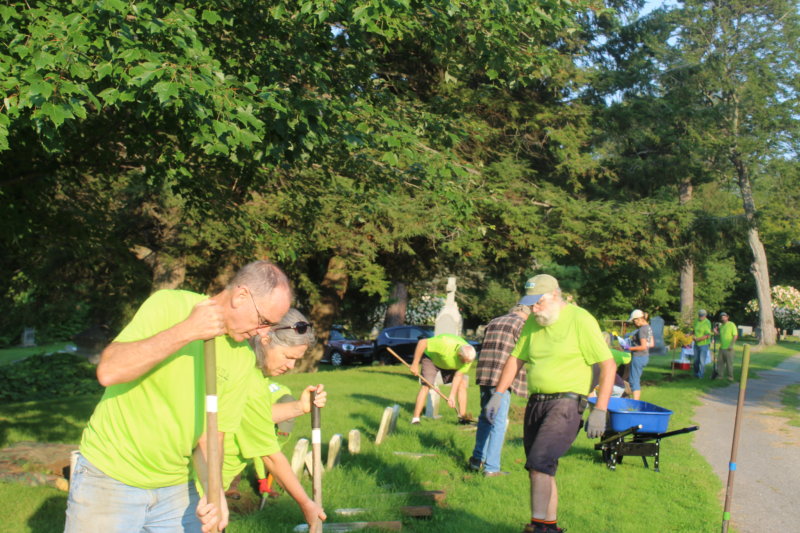LaBerge and Leary: Volunteers with a grave commitment
Diane Leary thinks it may be genetic. That may be why she spends so much of her free time in cemeteries.
For her husband Jim LaBerge, it may be a fascination with working in stone. It’s also part of his responsibility as two of three Charlotte cemetery commissioners.
That’s right; he’s two of three. It’s better than being all three, which is how it was when his wife decided to run LaBerge for the office.
LaBerge maintains, although Leary disputes this, that she got him elected without him even knowing it.

“When you know how to do something, and your wife knows you know how to do it, and she’s already got an interest in it …,” he doesn’t finish that sentence.
But we glance across the cemetery where Leary is up to her elbows, digging out a hole to receive a fallen headstone.
As a write-in candidate, he won all three of the seats. Local historian Dan Cole agreed to take one of the cemetery commission seats, but he’s so involved with historical research, he doesn’t have time for historical repair work.
LaBerge and Leary both say that it’s just coincidence that they spend so many weekends in graveyards and that Leary’s grandfather started the Vermont Old Cemeteries Association in 1958.
Leon Dean was an English professor at the University of Vermont whose love of Vermont history led him to write 11 books on the subject and to found the organization popularly known as VOCA.
On the morning of Sept. 3, the couple was already hard at work putting gravestones back together and in place at the Barber Cemetery on Greenbush Road. LaBerge said he suspects he’s repaired 40 broken gravestones at the cemetery

“I love working in the cemetery. One of the reasons is we’ve got the best view in town. A lot of people think it’s Mt. Philo, but I don’t know,” Leary said. She paused from tamping down dirt at the bottom of a hole to make a solid base to evaluate the view of Mt. Pease to the east, but after the merest of moments, she’s back at work.
A study the cemetery commission did with ground-penetrating radar several years ago found all the graves in Barber Cemetery are on the east side of the headstones. Even in the late 1700s, the first colonist settlers appear to have wanted their loved ones to enjoy the view from their repose.
LaBerge worked in stone for at least 16 years. Prior to that he was a dairy farmer, but when he got hurt farming, he hooked up with Peter Demick of Vermont Walkways and Stones of Charlotte where he learned the craft and worked for about 11 years.
These days he works at Harbour Industries in Shelburne. When the ovens there are fired up, the temperature is 10-15 degrees hotter than the outside temperature, so he doesn’t move, lift and repair gravestones in the summer heat after work — or on weekends. This sunshiny but comfortably coolish day was the first in a while since he has been outside, tackling his volunteer job.
LaBerge is meticulous as he chips off a dried, inferior epoxy to get a clean surface on a headstone that’s broken in two. Someone has tried to repair this headstone with a poor epoxy. He wants to make sure when he glues it together, it stays together.
“I learned from a high-end stonemason. A lot of guys that come in throw epoxy down, throw this back up,” LaBerge said. “It’s all these little things that make a big difference.”
Although there are several graves in the Barber Cemetery from the 1790s, they were not sure what the oldest grave was.
Cole knew. The oldest grave is James Squier’s. He died in 1785 at the age of 55 and was the first person of European descent buried in Charlotte.
Squier, a veteran of the Revolutionary War, was from Connecticut. He had come to visit his offspring. He had at least two sons, Solomon and Abner, who were among the earliest settlers in Charlotte. The first settlement here was established in 1784, so they were likely still building their homes.
Squier became ill during his visit, died and was buried in what was then known as the West Burying Ground.
As the years passed, cemeteries came to be known by the names of prominent people in the vicinity.
The Barber farm still surrounds this cemetery on three sides.

If LaBerge and Leary did work during the summer heat, they could be gone to cemeteries around Vermont every weekend from April Fools’ Day to Halloween.
“If somebody in the community’s got the interest, I love to go in and teach them how to do it. I don’t want to do everything for them. But I will show you how to do it and I will work,” LaBerge said.
The weekend before, Leary had been in Rutland. The weekend after this, on Saturday, Sept. 10, Leary and LaBerge were both in Burlington’s Lakeview Cemetery.
The weather was an almost exact replica of the previous Saturday in Charlotte, except this time as the temperature climbed it was abated by a wind blowing off Lake Champlain. And the view was to the west with sailboats frolicking and the Adirondacks providing the backdrop
And this time it was a much larger group. LaBerge and Leary joined more than 40 volunteers working on about 50 gravestones of children from the Home for Destitute Children, who had died from the 1870s into the early 1900s.
Up and down a line of simple but askew headstones, people were working to set them plumb and symmetrical, digging holes to reset them and stringing twine to see that they formed a solemn, respectful procession of memorials.
Once again Leary was clearing out holes where gravestones had stood, squaring up and tamping the fill to make a firm foundation, but this time she was one of several working at the same task.
Likewise, LaBerge was repairing stones and showing other volunteers what he was doing and how.
The group of volunteers appeared to be an almost balanced mix of novice and experienced. Tom Giffin, president of the Vermont Old Cemetery Association, said there were volunteers this day from all over Vermont and even one from New Hampshire.
“Basically, every weekend, we’re somewhere around the state doing this,” Giffin said.
Most weekends, the Vermont Old Cemetery Association is working in abandoned or neglected cemeteries. The Lakeview Cemetery is certainly neither abandoned nor neglected, but the section of destitute children’s graves needed some work. And there aren’t any family members, if there ever were, who could or would, tend to them.
Giffin had come up from his home in Rutland at 6:30 a.m. to work on these headstones. The next weekend he would be closer to home in Clarendon.
Just like LaBerge and Leary, Giffin is motivated by the desire to preserve history and concern about cemeteries that have fallen into disrepair.
Giffin gets calls all the time from places like Maine and even Texas. “We’re the first cemetery association in the nation and people copy us,” he said.
Denise Vignoe, director of development and communication with the Howard Center, said the Home for Destitute Children was originally formed in 1865 to care for orphans from the Civil War.
Originally housed at 447 Main Street in Burlington, it soon moved to a former military hospital on Shelburne Road on the southwest corner with Home Avenue, which takes its name from the Home for Destitute Children. A shopping center anchored by the Market 32 grocery store is where the home was located with its “spacious verandah, high ceilings, marble mantels and a view of the lake,” according to a historical overview from the Howard Center.
The home became a place for more than only orphans, including children from families that were too poor to care for them, victims of abuse or neglect, or from parents who struggled with mental illness or addiction.
“Some left as adults while many were adopted by families both in and beyond Vermont,” according to the overview.
Meghan Cope, a professor in the department of geography at the University of Vermont, has done an intensive study of handwritten logbooks from the home. She didn’t find many children from Charlotte who lived at the Home for Destitute Children, but there were several Charlotte families who adopted or fostered children from the home.
After volunteering so much time working on the graves of others, LaBerge and Leary don’t want to be buried. Both of them plan to be cremated.
“I told my kids, ‘When I die, have me cremated. Wait until spring. When you see somebody out planting corn, sneak over and help fertilize it,’” LaBerge said.
(If you would like more information about the Vermont Old Cemetery Association, want to volunteer or to donate, send an email or visit the website.)

